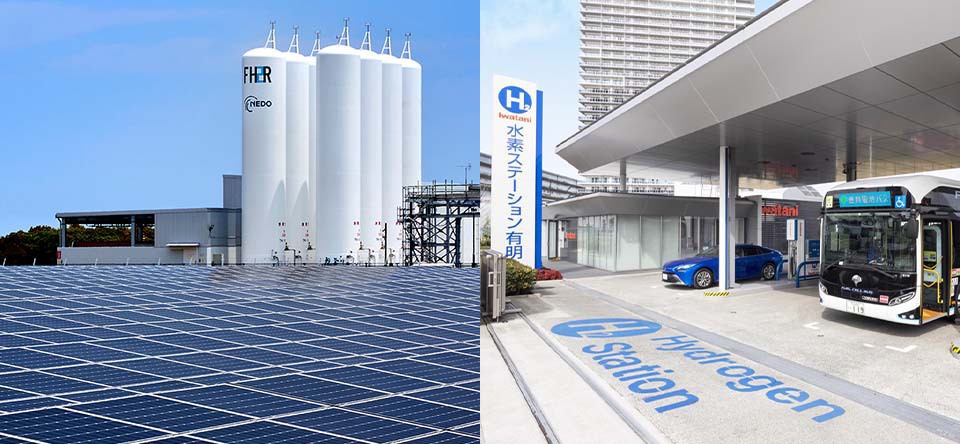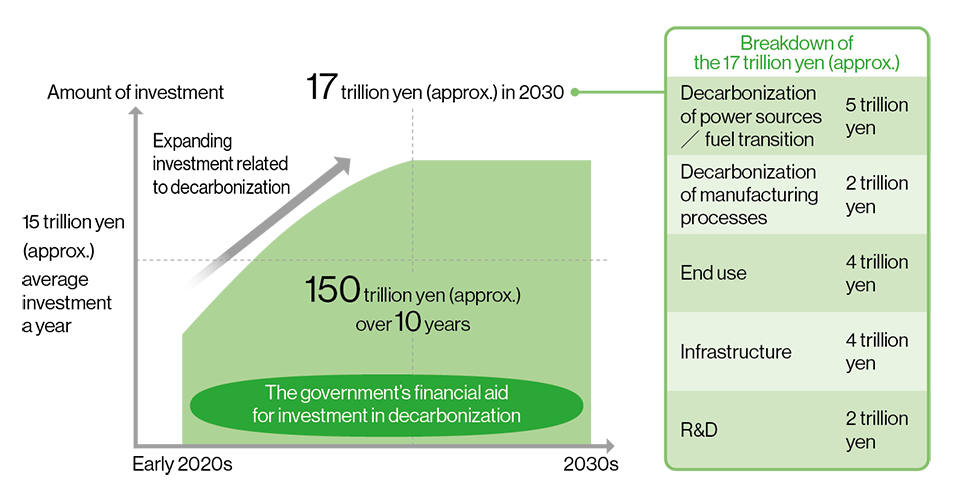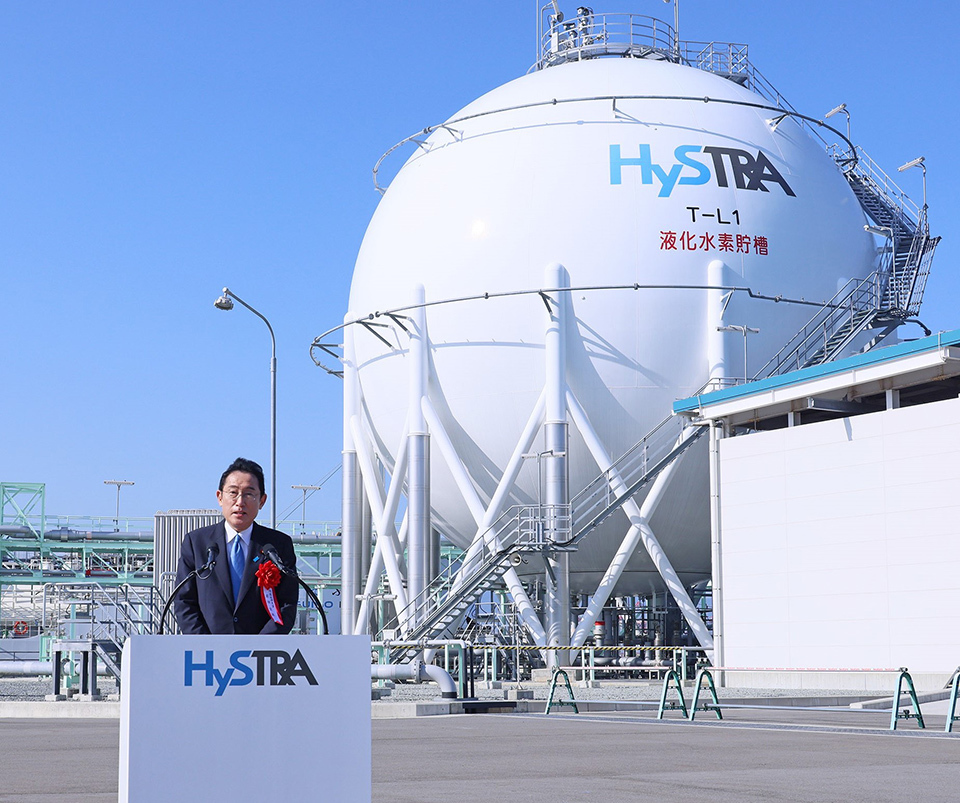The Japanese government issued an interim report on its “Clean Energy Strategy” in May. While aiming to achieve the goals of carbon neutrality by 2050 and a 46% reduction in greenhouse gas emissions in fiscal 2030, further growth will be achieved by ensuring a stable and affordable energy supply for the future.

Japan will draw out extensive investment in areas of anticipated growth, such as hydrogen. The photos show FH2R (Fukushima Hydrogen Energy Research Field) in Fukushima–one of the world’s largest hydrogen production plants (left), and a hydrogen refueling station and fuel cell buses operated by the Tokyo Metropolitan Government (right).
Japan has accelerated the steps taken to achieve decarbonization in order to meet two ambitious goals–namely, carbon neutrality by 2050 and a 46% reduction in greenhouse gases (GHG) in fiscal 2030. However, while progress is underway, the circumstances related to energy security have been dramatically upended by the Russian invasion of Ukraine. It is crucial for Japan to strive to reduce its reliance on Russia, and to accelerate decarbonization, while ensuring a stable supply of energy.
Ensuring energy security
Against such a backdrop, the government issued an interim report in May on its “Clean Energy Strategy” so that taking measures to combat global warming could lead to growth.
Firstly, it outlined a path to firmly ensure Japan’s energy security and to accelerate decarbonization. A short-term transition away from a reliance on Russia is necessary for Japan to reduce its current dependence. In addition to energy diversification, the broadening of procurement sources other than Russia is promoted through the government’s involvement in LNG purchasing and so on. Also, Japan, in cooperation with other major energy-consuming nations, will encourage energy producing nations to increase output. A stable supply of energy must be absolutely secured, and on the premise of that, efforts toward decarbonization are accelerated through “maximum utilization of power sources with high security and decarbonization such as renewable energy and nuclear power.”
Reforms in economy, society and industrial structure toward a carbon-neutral society
Furthermore, the government has stipulated such efforts towards realizing an industry-wide green transformation (GX) for decarbonization to lead to economic development and growth, and upgrading social systems and infrastructure to achieve GX on the interim report. In order to shift to a society, economy and industrial structure centered on clean energy, it is anticipated that some 150 trillion yen in investment will be required via public and private partnerships over the next decade.
As a framework for policy responses to draw such investment, five pillars have been outlined: (1) budgetary measures, (2) regulations and systems, (3) financial packages, (4) step-by-step development of the GX League, and (5) global strategies. Prime Minister Kishida also stated that about 20 trillion yen of government funds would first be raised in the form of GX Economic Transition Bonds (tentative), backed up by securing future financial resources, with consideration given to quickly directing such funds to support investment. Further discussions will be held to materialize these policy responses.
Scale & Timeframe of Investment Related to Decarbonization

Fiscal 2023 will see the full-scale launch of the GX League in Japan, enabling discussions across industry, government, and academia to implement all aspects of GX, including emissions trading. During the preparatory stage in fiscal 2022, this was endorsed by 440 companies that account for more than 40% of Japan’s entire emissions. With the GX League, participating companies set their own emission reduction goals consistent with those of the country, and annually disclose their reduction efforts toward those goals. Then, if their individual reduction goals set by the companies are not achieved, emissions will be traded between participating companies or carbon credits will be procured. The intent is for the GX League to develop into a mechanism that stimulates reduced emissions and promotes investment.
The “Asia Zero Emissions Community Initiative” as focused on by the Kishida Administration is one of the global strategies to enhance cooperation with other Asian countries. Japan will strive for cooperative decarbonization across Asia by promoting joint demonstrations, international investment, and establishing standards for zero-emission technologies for biomass, hydrogen, ammonia, carbon capture, utilization and storage (CCUS), and so forth, while utilizing the region’s credit markets.
Creating a Global Hydrogen Supply Chain for Sustainable Energy

PM Kishida, attending a ceremony to mark the completion of marine transport demonstration tests of the world’s first liquified hydrogen carrier, stressed, “We must complete our structural shift concerning energy, and establish a foundation for our future.”
The use of hydrogen as an energy source is considered key to achieving carbon neutrality by 2050. Japan has been quick to focus on hydrogen, as demonstrated by its drawing up of a hydrogen utilization road map in 2014 and being the first country in the world to formulate a national hydrogen strategy in 2017.
In February 2022, the world’s first liquified hydrogen carrier successfully conducted its marine transport demonstration tests. The vessel was loaded with hydrogen produced in Australia, which was then transported back to Japan by sea. Upon returning to the Port of Kobe, its cargo was off-loaded, thus completing its first trial journey.
Japan aims to commercialize an international hydrogen supply chain by producing hydrogen in bulk at low cost in countries blessed with bountiful renewable energy resources coupled with marine transport infrastructure.






























